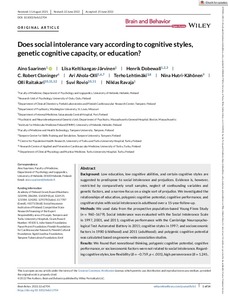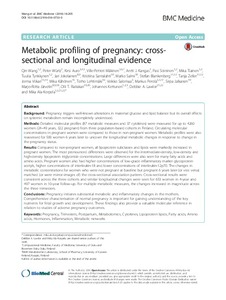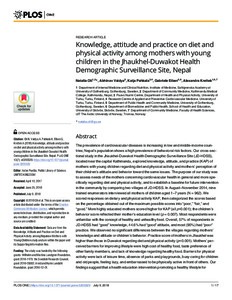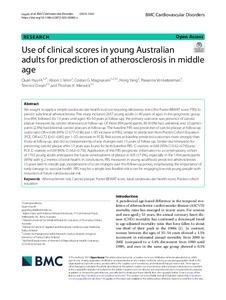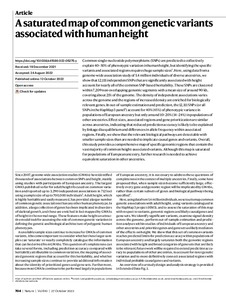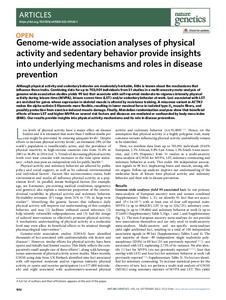Hae
Aineistot 351-360 / 389
Does social intolerance vary according to cognitive styles, genetic cognitive capacity, or education?
<p>Background<br>Low education, low cognitive abilities, and certain cognitive styles are suggested to predispose to social intolerance and prejudices. Evidence is, however, restricted by comparatively small samples, neglect ...
Progressive multifocal leukoencephalopathy in Finland: a cross-sectional registry study
<div><h4><b>OBJECTIVE</b>:To investigate if progressive
multifocal leucoencephalopathy (PML) incidence has increased in Finland
like in the neighbouring Sweden.</h4><div><br /></div><h4><b>METHODS</b>: National ...
Metabolic profiling of pregnancy: cross-sectional and longitudinal evidence
<div><h3>Background</h3><p>Pregnancy triggers well-known alterations in maternal glucose and lipid balance but its overall effects on systemic metabolism remain incompletely understood.</p></div><div><h3>Methods</h3><p>Detailed ...
Knowledge, attitude and practice on diet and physical activity among mothers with young children in the Jhaukhel-Duwakot Health Demographic Surveillance Site, Nepal
The prevalence of cardiovascular diseases is increasing in low and middle-income countries; Nepal's population shows a high prevalence of behavioral risk factors. Our cross-sectional study in the Jhaukhel-Duwakot Health ...
Use of clinical scores in young Australian adults for prediction of atherosclerosis in middle age
<p>We sought to apply a simple cardiovascular health tool not requiring laboratory tests (the Fuster-BEWAT score, FBS) to predict subclinical atherosclerosis. This study included 2657 young adults (< 40 years of age). In ...
Association of the American Heart Association’s new “Life’s Essential 8” with all-cause and cardiovascular disease-specific mortality: prospective cohort study
<p><b>Background </b>The American Heart Association recently updated its construct of what constitutes cardiovascular health (CVH), called Life’s Essential 8. We examined the association of total and individual CVH metrics ...
Cumulative dyslipidemia with arterial stiffness and carotid IMT progression in asymptomatic adolescents: A simulated intervention longitudinal study using temporal inverse allocation model
<p>Background and aims</p><p>We aimed to examine the longitudinal associations of total cholesterol (TC), non–high-density lipoprotein cholesterol (non–HDL-C), high-density lipoprotein cholesterol (HDL-C), triglyceride, and low-density lipoprotein cholesterol (LDL-C) with carotid-femoral pulse wave velocity (cfPWV) and carotid intima-media thickness (cIMT) progression.<br></p><p>Methods</p><p>We studied 1779, 15-year-old participants from the Avon Longitudinal Study of Parents and Children, UK birth cohort, followed up for 9 years. Fasting TC, non–HDL-C, HDL-C, triglyceride, and LDL-C were measured at 15, 17, and 24 years and age-categorized as normal, elevated, and dyslipidemia based on National Heart, Lung, and Blood Institute lipid guidelines. cfPWV and cIMT were measured at 17 and 24 years. Associations were examined using linear mixed-effect models. To simulate the treatment of dyslipidemia we conducted temporal inverse allocation model analyses.<br></p><p>Results</p><p>Among 1779 [49.9% female] participants, mean lipid levels and proportions at elevated or dyslipidemia categories increased from ages 15 through 24 years. Persistently elevated TC: effect estimate 0.026 mm; [95% CI 0.004 to 0.049; p = 0.024], elevated non–HDL-C, and elevated LDL-C were cumulatively associated with cIMT progression. Persistent borderline-low HDL-C: −0.027 mm; [-0.050 to −0.005; p = 0.019] and very-low HDL-C −0.035 mm; [-0.057 to −0.013; p = 0.002] levels were associated with cIMT progression. A temporal inverse allocation of elevated and dyslipidemic levels with normal lipid levels at age 17 years attenuated the associations of cumulative elevated TC, non–HDL-C, LDL-C, and low HDL-C with cIMT progression. Cumulative elevated lipids or dyslipidemia were not associated with cfPWV progression.<br></p><p>Conclusions</p><p>Late adolescence is key to preventing, halting, and reversing dyslipidemic-related preclinical atherosclerosis progression, warranting universal lipid screening in the general pediatric population.</p>...
A saturated map of common genetic variants associated with human height
Common single-nucleotide polymorphisms (SNPs) are predicted to collectively explain 40-50% of phenotypic variation in human height, but identifying the specific variants and associated regions requires huge sample sizes(1). ...
A genome-wide association study of total child psychiatric problems scores
<p>Substantial genetic correlations have been reported across psychiatric disorders and numerous cross-disorder genetic variants have been detected. To identify the genetic variants underlying general psychopathology in ...
Genome-wide association analyses of physical activity and sedentary behavior provide insights into underlying mechanisms and roles in disease prevention
Although physical activity and sedentary behavior are moderately heritable, little is known about the mechanisms that influence these traits. Combining data for up to 703,901 individuals from 51 studies in a multi-ancestry ...
